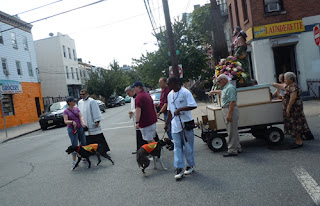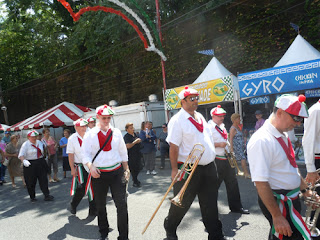Good Saint
Rocco. Blessed Saint Rocco. Although of French descent, this saint is a
popular devotion throughout Southern Italy, especially Sicily.
At Holy Rosary church in Jersey City, he’s a bit of
a step child when it comes to the Italian Feast, but so it goes for a saint whose
feast day follows the Feast of the Assumption, a holy day of obligation, major Blessed
Mother icon and key theological component of Roman Catholic Dogma. According to
Parish lore, rivalries existed within the parish between groups of immigrants
who retained their village devotional preference for separate mid-august
novenas (Saint Rocco now receives a Triduum of prayers, mass and worship, which
is three days). There may even been competing street fairs within the same handful
of blocks, but some history cannot be verified. Can’t imagine though, much if
any significant animosity arising among the camps within what is claimed to be
the oldest Italian parish in New Jersey.
Whatever there was, was resolved decades ago. Saint
Rocco gets his due, with a special Mass and procession and with a little
smaller but perhaps a little more enthusiastic crowd. And after the mass, the
men processed the statue out of the church and onto the same wagon used to haul
the Assumption statues the day before. Pots of fresh flowers were also placed
on the mobile platform. Red Mikes’ FestivalBand played a mix of hymns and Italian songs. Two representatives from the
Liberty Animal Shelter had pit bulls on leashes. The dogs wore adopt me bibs. Saint
Rocco’s icon includes a dog so the canine presence was appropriate.
There seemed to be a lot more elderly at the mass
and on the street outside the church as the procession was organized. The
elderly even seemed more elderly, compared to the day before. They had not
attended the assumption day mass and procession even though it was held at the
same time of day. Dignified senior citizens, using canes to walk, you could
tell that for some it was not easy to be here but by their faces and the faces
of everybody who recognized them, the effort was worth it.
This procession also made more stops than the
assumption march. The blocks around Holy Rosary mostly remain an Italian
enclave. Senior citizens, presumably homebound, waved from windows and the
procession stopped often for people to pin more bills to the ribbon adorning
the statue. Judging from the folks in
the windows and on the stoops, the Saint Rocco procession attracted more spectators.
Imaging these same streets filled with
people waving from the windows seemed easy. The tradition of processing with
Saint Rocco is decades old, probably as old as Holy Rosary itself and just as
many there remembered past processions – reminiscences dominated the talk,
which was probably true back in their day too. Traditions always inspire nostalgia,
memories are shared and passed down and the passing down of those memories are
as much a part of the ritual as the actual customs. There were probably
processions were the reminiscences were entirely of processions in Sicilian
villages, dating back to the time of plague when St. Rocco was alive.
Saint Rocco was
French, of Noble birth, his father a governor. On his 20th birthday,
following the example of St. Francis, he donated his wealth to the poor and embarked
on a pilgrimage to Rome. It was the 14th century and the plague was
ravaging Europe. He ministered to the sick in public hospitals, was said to have
performed miraculous cures as he made is way towards the center of European Christianity.
Eventually, he fell ill and was thrown out of a village, so he made himself a
shelter of branches and leaves and would have died but a nobleman’s dog would
bring him bread and lick his wounds. One day, the nobleman followed his dog and
discovered the saint, and became a follower. When he was fully healed, St.
Rocco went back home and was falsely accused of being a spy – or of murdering
someone, stories differ – and was thrown in prison by his own uncle, who did
recognize him. He died in prison on August 16th (most saint feast
days are celebrated on the date of their death), but was identified by a
birthmark in the shape of a crucifix. Also, the cell was filled with light,
according to some accounts.
The celebrant
of the Saint Rocco mass gave a homily that made much of the pilgrim aspect of
the saint, the idea being we are all on a pilgrimage, a spiritual journey.
Along the way, Saint Rocco followed the teachings of Christ. He gave his wealth
and time to the poor and suffering. He lived a life of compassion. For
Americans, pilgrim has additional connotations being that early creation myth
are of the pilgrims fleeing persecution and after a year held a turkey dinner
with the then Native American neighbors. The hat on Saint Rocco would not look
out of place on a puritan’s head. Pilgrims
embody a personal statement about faith, and a healthy disregard for authority.
More than two
centuries had passed after Saint Rocco’s death before Pope Gregory XIV canonized
him. This passage of time is not unheard of – Saint Joan of Arc took about half
a millennium – what is revealing though is that a catholic church in his name
was erected in Montpellier, his hometown
and feasts were celebrated by 1390, a mere 20 years after his death. He was “venerated in the popular mind”
throughout Italy, where his travels and the miracle of the dog were well known,
as well as France and Spain – during the two centuries preceding official
recognition. These were the decades of the Black Death, bubonic plague which
decimated populations and one can imagine that a contemporary saint was a
useful focal point for home during these horrific years.
Many of the
icons and devotions in Catholicism actually have a similar history of rising
among the people and majorities resisting official recognition until they seem
to have no other choice but bending to the popular will. A nobleman giving up
his goods and tending to the sick before succumbing to the same sickness seems
like a subversive idea in an era where near-poverty peasants, who were essentially
slaves to lords and other noblemen – were dying in droves while the leaders,
including church leaders, lived in unfathomable luxury far away from the
diseased corpses rotting in the muddy streets of the village. Saint Rocco’s
story was a threat to the status quo and it took several generations (and one
assumes effective devotions) before the leaders had no other choice but to acknowledge
what the faithful laity already knew.
My favorite
Saint Rocco attribution is the patron saint of pestilence. And like back in the
plague years between the crusades and the renaissance, the intercession of Saint
Rocco is prayed for in times of sickness and disease and infective illnesses.
Because of the canines in his depiction, he is also prayed to as the patron
saint of dogs.
We walked, we
talked and in the back yard entrance to Holy Rosary on Seventh Street the
procession concluded with coffee and cake.
Saint Rocco is about compassion and hope. During desperate times – some
of the most desperate in world history, the plague was more devastating than
war – people found consolation in prayers for his intercession. So many that the authorities were finally forced
to embrace the saint. After the plague subsided, the people get the mass,
procession and feast alive. We live with death even when it’s not so apparent.
But the better angels of our nature – as Lincoln said, a quote which the priest
at the Holy Rosary mass alluded to – make us strive towards compassion and live
with hope alongside death and all its anxiety. Saint Rocco’s procession reminds
us of that as it also reminds us of the tradition of processing that is a
century old.
As the statue
was brought back into the church through its basement, and the people followed
towards folding tables and refreshments, Red Mike’s Festival band played the
fitting finale. The Theme to Rocky.




























No comments:
Post a Comment